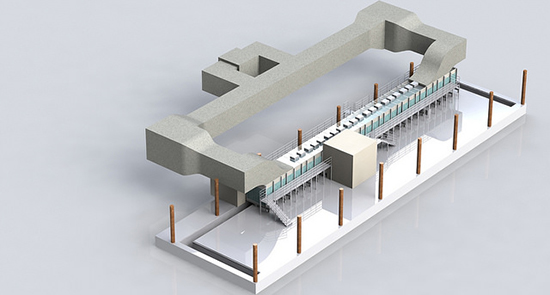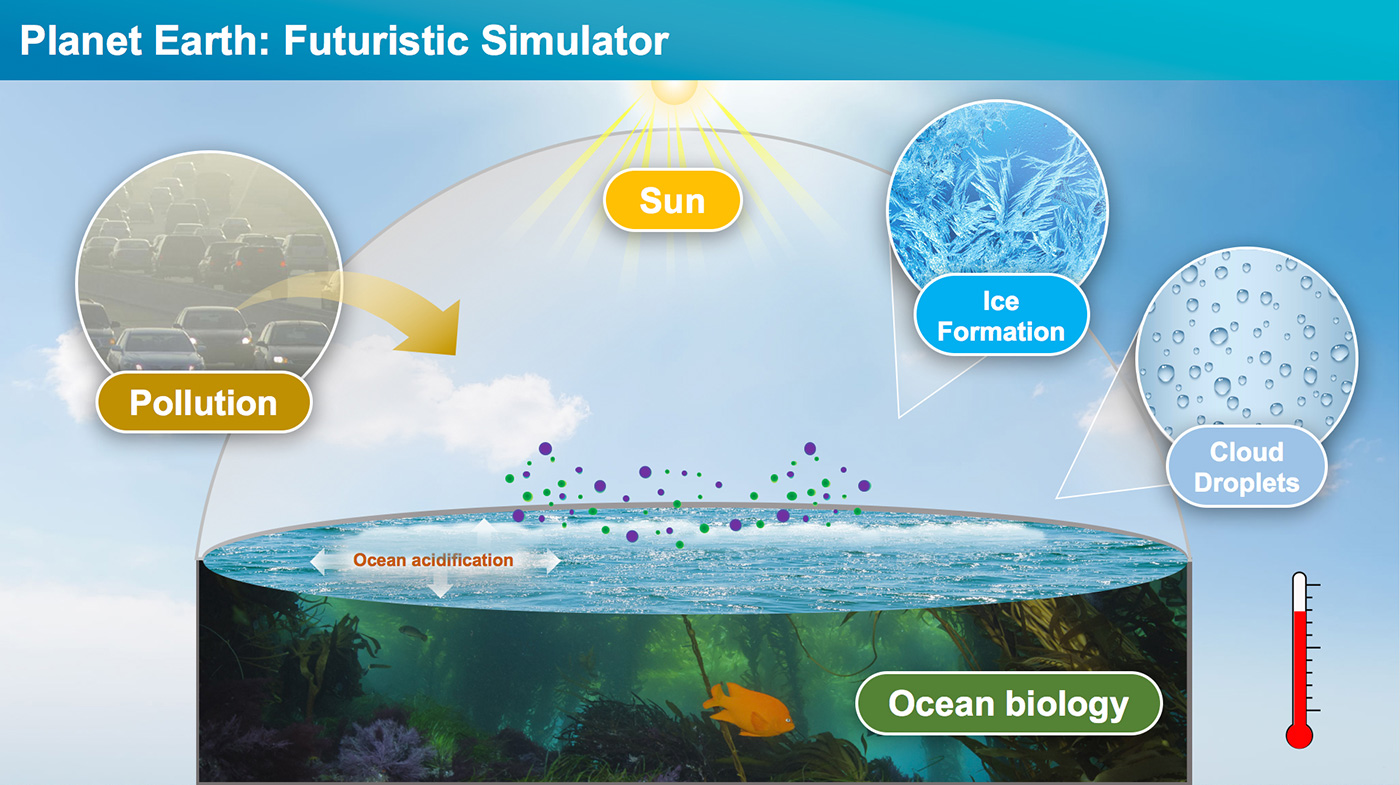NSF Awards Scripps Oceanography $2.8 Million to Develop Advanced Ocean and Atmosphere Simulator
First-of-its-kind simulator will replicate a range of ocean conditions and generate near-gale-force winds in controlled setting
Published Date
By:
- Rob Monroe
Share This:
Article Content

A 3-D rendering of the SOARS instrument funded by the National Science Foundation scheduled for completion in 2021.
The National Science Foundation (NSF) has awarded $2.8 million to the University of California San Diego to construct a replica ocean-atmosphere system on the Scripps Institution of Oceanography campus.
The new Scripps Ocean Atmosphere Research Simulator (SOARS) will mimic the ocean with unprecedented accuracy, capturing the interactions of wind, waves, microbial marine life, and chemistry at the sea surface in a laboratory setting. With SOARS, scientists will also explore how the introduction of pollutants by human activities are changing the chemistry of the ocean and atmosphere which could impact one way nature regulates climate.
Scientists will be able to generate winds up to 50 kilometers (31 miles) per hour, control air and water temperature to replicate tropical to polar conditions, and induce phytoplankton blooms of a wide array of species, while adding inputs such as air pollutants including greenhouse gases for studies of potential climate change effects in current and future oceans and atmospheres.
“It is the only instrument in the world capable of studying the current and future ocean/atmosphere system and a testament to 21st century science,” said project principal investigator Grant Deane, a Scripps research oceanographer. “We are building the tools we need to understand our changing planet and educate the next generation of scientists and engineers in whole earth science.”
The science team behind SOARS includes an atmospheric chemist, a microbiologist, and three physical oceanographers. The experiments planned for the facility are similarly broad and interdisciplinary.
“Research at this new facility will lead to an understanding of how pollutants and higher carbon dioxide levels affect marine animals and plants, cloud formation, and, ultimately, us,” said Rick Murray, director of the NSF’s Division of Ocean Sciences, which awarded the grant. “Through these studies, scientists will simulate how ocean ecosystems from the polar regions to the offshore California Current may respond to future environmental conditions.”
For project co-principal investigator Kim Prather, who directs the NSF Center for Aerosol Impacts on Chemistry of the Environment (CAICE) at UC San Diego, SOARS will enable more detailed study of aerosols, particles composed of sea salts, organic matter, viruses, and bacteria that are ejected from the ocean surface when waves break and winds blow. Such particles directly seed and form clouds. Sea spray aerosols and gases emitted from the ocean can change the properties of clouds which changes the temperature of the planet. Aerosol-clouds interactions are considered to be the most difficult variables in climate to understand.

Schematic created by SOARS scientists depicting the variables within ocean-atmosphere systems that scientists will be able to replicate using SOARS.
“Futuristic scenarios can be tested by increasing atmospheric CO2 and pollutant concentrations and studying how these would lead to changes in ocean acidity and the associated biological responses and emissions,” said Prather, the Distinguished Chair in Atmospheric Chemistry and a faculty member at Scripps and UC San Diego’s Department of Chemistry and Biochemistry. “Sunlight and sea surface pollutants could interact to create new species of gases and aerosols that could be re-introduced into the atmosphere as toxins that could have potential health effects. SOARS will open the doors for science in the exploration of future as well as prehistoric scenarios that will allow scientists to sort out human-natural interactions at a level that cannot be achieved in the real world.”
Another project co-principal investigator, Scripps microbiologist Farooq Azam, said SOARS could lead to improved understanding of the ocean food web.
“The rigorously simulated and controlled ocean-atmosphere boundary layer, enabled by SOARS, should help address fundamental questions on the ecology of microbes at the air-sea interface which is important for predicting the future state of the ocean-atmosphere system,” said Azam. “Further, the powerful capability of SOARS to simulate different controlled ecosystem scenarios will help us understand the mechanisms of variability in the structure and ecosystem function of the microbial food web and significance for carbon cycle and climate change.”
SOARS represents the evolution of Scripps’ environmental simulation equipment. For nearly 50 years Scripps scientists had been using tanks to generate waves and replicate some ocean processes in the laboratory. The new instrument will continue experiments in fluid dynamics, physical oceanography, and marine engineering.
The total cost of SOARS is $4 million, with $1.2 million provided by Scripps. Design of the instrument has begun with experiments scheduled to begin in 2021. It will occupy the site of an existing wave flume in the Hydraulics Laboratory at Scripps. That flume is scheduled to be decommissioned in 2018.
NSF is supporting SOARS under Grant Number OCE-1727039.
Share This:
Stay in the Know
Keep up with all the latest from UC San Diego. Subscribe to the newsletter today.



